| BrianRxm | Coin Stories | 2/16 |
| The French Key - A 1940's Numismatic Mystery Film and Novel |
Coin Collectors, Rare Coins, Gold Hoarding, 1822 Half Eagle
| Prev | Back | Next |
"The French Key" is a 1946 crime and detective film.
The film starts with a man finding a dead man's body in his hotel room and then finding a gold coin
clutched in the dead man's hand.
I was able to locate a copy of the film and the novel the film was based on.
The Story:
The French Key was first a book published in 1939 and made into a film in 1946.
The book was published under the title as The French Key Mystery and was written by Frank Gruber,
a prolific writer of westerns and mysteries, who also wrote the screenplay for the film.
The story has numerous mentions of American numismatic topics of the 1930's.
The book was republished as an Avon Paperback in 1946 and then in 1970 with a new cover.
The book is a comedy-mystery about two wise-cracking amateur detectives who find a dead body
and an old gold coin in their hotel room. They become suspects and set out to find the "real killer."
The old gold coin, an extremely rare United States half eagle five dollar gold coin dated 1822,
leads them to a crooked coin dealer, a wealthy coin collector, an old gold mine, gold bullion hoarders,
and, of course, pretty women.
In 1933 President Roosevelt and the Congress took the United States off the gold standard and
issued regulations requiring Americans to turn in their gold coins (with some exceptions) to the government.
In 1934 the US government raised the price of gold from $20.67 per troy ounce to $35.00.
This meant that a $20 gold coin was worth it's face value as a coin but melted would be worth around $35.
There is some discussion in the book of rare United States coins and their prices at the time,
along with gold hoarding and profitable but illegal schemes to circumvent the 1933 gold regulations.
The Book:
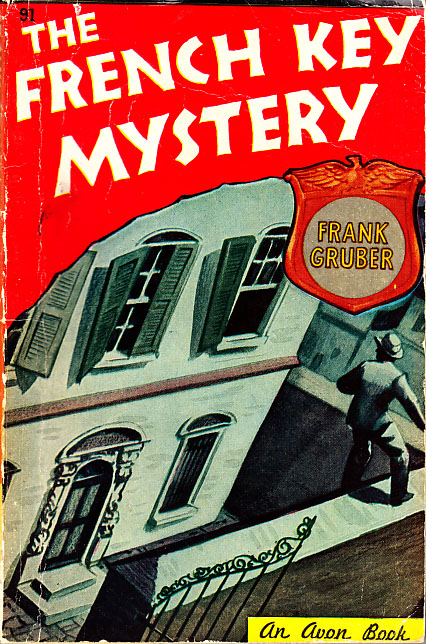
1. The French Key paperback book cover 1946
The book inside cover description:
THE FRENCH KEY MYSTERY is ingenious and exciting, the dialog quick and amusing,
and the writing fresh and skilful.
A young man returns to his hotel room in New York to find that the management has locked
him out of his room by means of a French key - an ingenious device - because he has failed
to pay his rent. By dint of a little climbing the young man contrived to circumvent the management
and get into his room. There he found a dead man and an unusual gold coin.
From the first page the story never slackens.
The identity of the beautiful girl in the next room, the complicated doings of a group of
wealthy numismatists - we think that means coin fanciers - and the luck connected with a
decorative iron bear, all play a part in the working out of this spirited story.
Johnny Fletcher and Sam Cragg are two amateur detectives who live in New York.
The time period is around 1939 as a character mentions that the 1822 coin is 117 years old.
They are both short of money and have not paid their hotel room charges of $36.45.
Fletcher returns to the hotel room and finds that his room key will not open the door.
He discovers that a "French key", a piece of soft metal, has been pushed into the lock
by the hotel manager.
He sees the manager who tells him that he owes three weeks rent.
In those days, people with luggage could check into hotels without paying in advance and
would be asked for payment after a week.
Cragg has a key to a adjoining room and Fletcher enters the room and climbs out the window
onto a balcony and enters his room through the window. He then makes an unpleasant find,
a dead body laying on the bed with his throat cut. Cragg then follows Fletcher to the room and
Fletcher finds a five dollar gold coin in the dead man's hand.
Fletcher visits a rare coin dealer named Vedder who looks at the coin and tries to cheat
Fletcher by claiming that the coin is dated 1812. Fletcher knows something about coins
and the dealer admits that it is an 1822 gold half eagle, the most valuable American coin
in existence and worth $15,000. The dealer also tells Fletcher that an 1812 half eagle
is worth $25 in mint condition.
Fletcher mentions that he once saw a advertisement "Old Money Wanted" and ordered a
50 cent book on old coins. It told him that his 1879 nickel was only good for a subway ride.
Although no details about the advertisement are given, Max Mehl, the famous Texas coin dealer,
placed such ads in magazines in the 1930's.
The two men visit a wealthy coin collector and discuss coins.
Real coins mentioned include Clark and Gruber Denver private mint 1860-1861 $20 coins, a
"tetradrachma of Thrace coined around 400 B.C.", a "Tiberius silver denarius", a "Justinian aureus",
and a "gold sixty sesterzen of Campania."
One can wonder if there was a connection between the author Frank Gruber and the
Clark and Gruber mint.
The dead man is identified as Billy Tamm, a prospector and miner from Nevada.
He had been hired by a wealthy Wall Street businessman named Winslow as a watchman
for a defunct gold mine named the "Three Bears Mine" near Bad Axe, Nevada.
Tamm would explore the ghost towns and would pick up old coins under saloons.
Several years earlier Tamm sold to the coin dealer an 1853 half dollar without arrows,
also an extremely rare coin, for $600. The dealer mentions that Tamm could have found a
Clark and Gruber $20 gold piece which would be worth $200 to $300.
A Treasury Department agent explains that they have reason to believe that the Sunset Mine
near Bad Axe is selling ingots to government which were mined gold mixed with gold currency
(gold coins) which means that the mine was converting $20/troy ounce gold coins to $35/troy ounce
bullion which was illegal.
The treasury agent explains:
I'm an agent of the Treasury Department.
I specialize in matters pertaining to the illegal possession of gold.
To put it briefly, I track down gold hoarders.
You know, of course, that when the country went off the gold standard possessors of
gold currency (coins) were required to turn it in to the government.
Prior to our going off the gold standard gold was worth approximately twenty dollars an ounce.
Today it is worth thirty-five. So if a man had four thousand dollars worth of hoarded
gold currency he could smelt that down and sell it for approximately seven thousand dollars.
At one point Fletcher spots the police waiting, enters a telephone booth,
deposits the gold coin into the nickel slot (local calls cost five cents then) to keep the
police from finding the coin. Later the telephone company collector is robbed of his
nickels by thugs who had been following Fletcher.
Winslow has three hollow iron statues of bears at his mansion to celebrate the source
of his wealth at the "Three Bears Mine." He was also using the statues to hide his stash of
gold coins. Later Winslow is also killed, supposedly in a car accident, but Fletcher doesn't think so.
Fletcher, Cragg, and Vedder fly to Nevada to visit the gold mine.
They find Tamm's coin albums and a book entitled "Numismatism - Every Man's Hobby."
Fletcher and Vedder enter the mine and find at the rear a box with 19 more 1822 gold coins.
The dealer mentions that the Captain Bonneville Expedition in 1833 may have left the 1822 coins.
Vedder claims that the coins are his but Fletcher keeps them.
Fletcher heads to the Winslow mansion and gives the 20 gold coins to Winslow's daughter Betty.
He tells her that one coin is worth $15,000 but more would lower the price.
Fletcher suggests to the daughter that she sell one coin to the coin dealer Vetter for $15,000
without letting him know there are more.
Finally the police, players, and suspects are brought together and the real killer is revealed.
Another book cover:
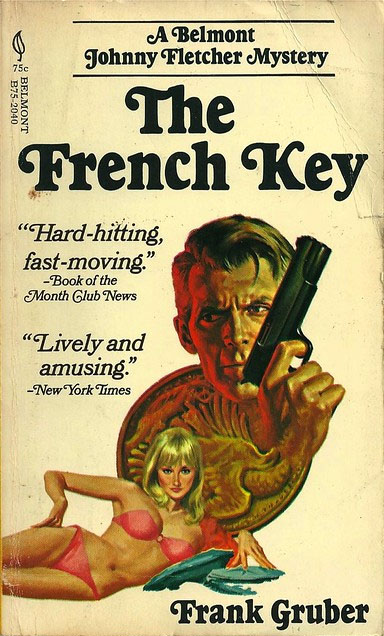
2. The French Key paperback book cover 1970
The book was reissued in 1970 with a cover inspired by James Bond and with, of all coins,
a Walking Liberty half dollar reverse.
Pay telephones (in 1946) had slots for nickels, dimes, and quarters.
Fletcher puts the coin into the pay telephone nickel slot where it stays.
From 1795 to 1829 the United States gold five dollar coin diameter was 25.0 mm and from
1839 to 1929 the diameter was 21.6 mm.
The diameter of the United States five cent nickel coin has been 21.2 mm from 1883 to the present.
Therefore an 1822 five dollar coin would not fit into the smaller nickel slot of a pay telephone.
The United States quarter diameter has been 24.3 mm from 1831 to the present.
The 1822 gold coin would have probably jammed if Fletcher tried to insert it into the quarter slot.
Note: There is a major mistake in the book:
The Film:
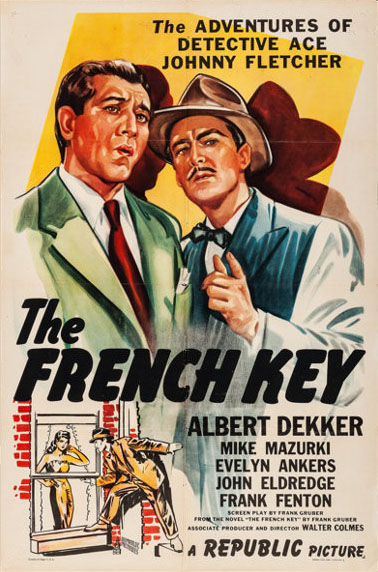
3. The French Key movie poster 1946
The 1946 Republic Pictures film "The French Key" tells the same basic story except that the
location has been moved from New York to Los Angeles.
The film starred Albert Dekker as Johnny Fletcher, Mike Mazurki as Sam Cragg,
and Evelyn Ankers as Janet Morgan; all were well-known stars of 1940's
detective, crime, and horror films.
There is no discussion of the foreign coins like the "tetradrachma" or "sesterzen."
The film also repeats the mistake of the gold coin not fitting into the pay telephone nickel slot.
The 1822 gold half eagle is portrayed by a real gold coin, an early 20th century French 20 francs coin.
For more information on the film please visit: Coins in Movies - The French Key
A few scenes from the film:
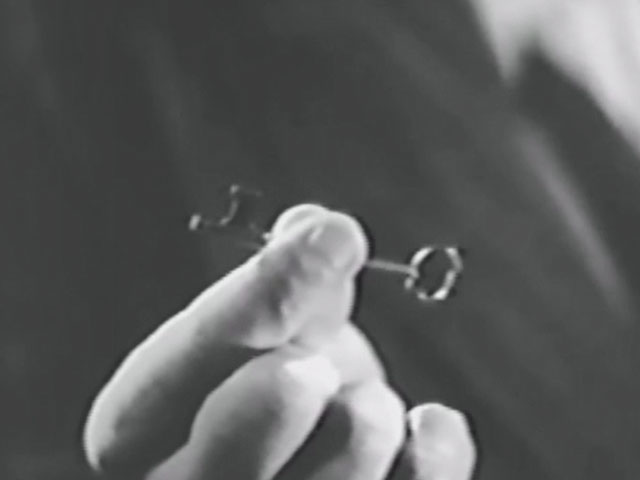
4. The French key of the title
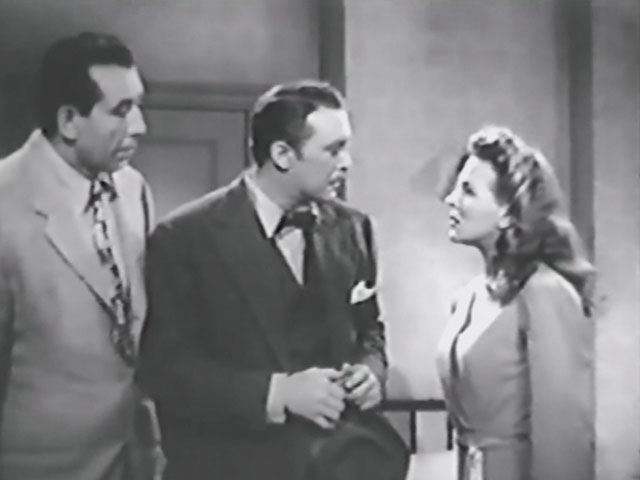
5. Sam Cragg, Johnny Fletcher, Janet Morgan
(Mike Mazurki, Albert Dekker, Evelyn Ankers)
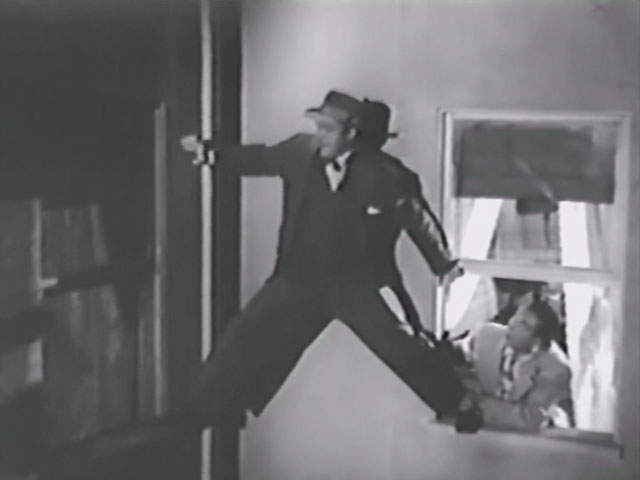
6. Between two windows
Fletcher moving between hotel rooms, a favorite scene in the book and movie, used on the
cover of the 1946 paper back novel and also in the advertising poster for the film.
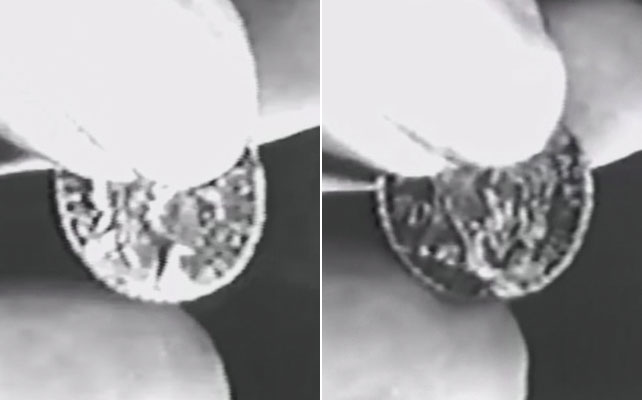
7. The French Key movie coin obverse and reverse
The coin in the film is a real French Marianne-Rooster 20 francs gold coin.
A French Marianne-Rooster gold coin:
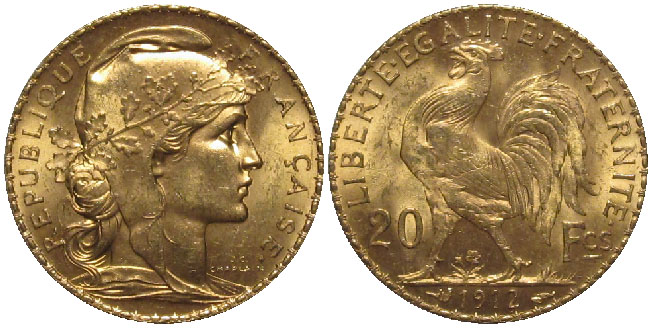
8. France 20 Francs 1912 Marianne-Rooster
Gold, 21 mm, 6.45 gm
These were minted in Paris from 1899 to 1914.
The moral of this story is to always pay one's hotel bill.
These were minted in Paris from 1899 to 1914.
| Prev | Back | Next |